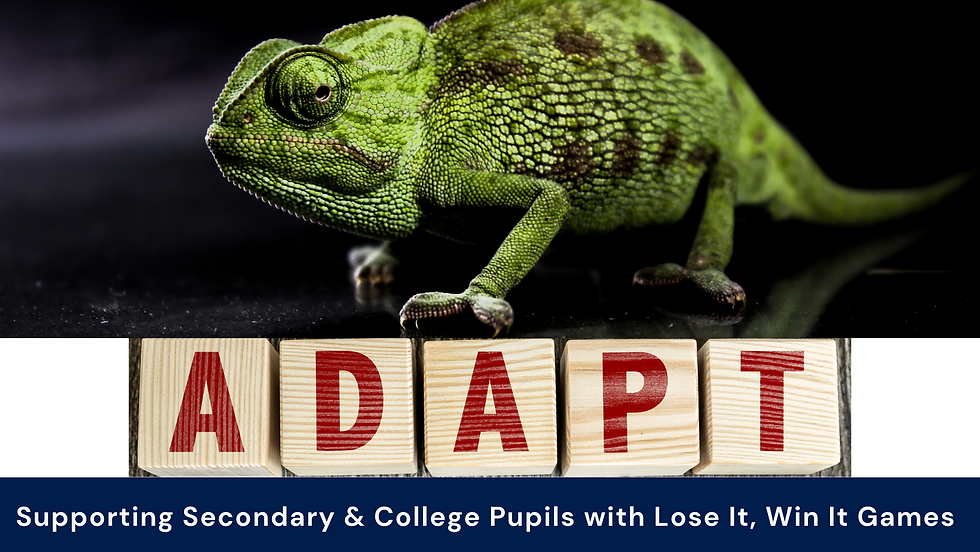From Chaos to Calm
- Sep 23
- 4 min read
Why Structure, Routines, and Predictability Matter for Neurodiverse Children: Everyday Impact of Change

Have you ever noticed how a minor disruption—like a supply teacher, a different route home, or a surprise change in timetable—can throw a neurodiverse child off balance?
For many children with autism, ADHD, or other SEND needs, structure and predictability aren’t preferences. They’re lifelines. They provide safety, reduce anxiety, and create the conditions for learning and positive relationships.
Theoretical Foundations
Structured Environments: The TEACCH Approach
The TEACCH model (Schopler et al., University of North Carolina, 1970s) shows how structured, visual, and predictable environments help autistic learners feel secure and more independent (Mesibov & Shea, 2010). Tools like visual schedules, work systems, and physical organisation clarify what’s expected and reduce uncertainty. If you didn't see my other BLOG about TEACCH, please check this out: https://www.beainclusive.com/post/21-how-to-set-up-your-first-teacch-station
🗝️ Key idea: “Structure turns invisible expectations into something children can see, predict, and manage.”
Executive Functioning Challenges
Autistic children and those with ADHD often struggle with planning, organisation, flexibility, impulse control, and working memory (Ozonoff et al., 2005). Structure acts as scaffolding for these executive function difficulties, helping children move between tasks and complete them successfully.
Cognitive Load and Learning
According to Cognitive Load Theory (Sweller, 2011), unstructured or unpredictable environments overload working memory. By simplifying routines and expectations, children can focus more on learning and interaction rather than surviving uncertainty.
Anxiety and Predictability
Uncertainty is a known trigger for stress and dysregulation (South & Rodgers, 2017). Predictability lowers anxiety and helps children regulate emotionally, creating space for growth.
Core Principles of Structure and Routine
Visual supports – e.g., daily timetables, “first–then” boards, colour coding
Clear physical structure – defined spaces for work, play, and calm-down
Consistency of routine – same order of activities; changes explained ahead
Transition support – countdowns, timers, visual cues, transitional objects
Choice within structure – limited, predictable options to encourage autonomy
💡 Reflective question: Which of these strategies do you already use at home or in school? Which might you try next?
Case Studies: When Structure Is Missing
1. Primary School
Ethan, age 7, becomes distressed every morning during transitions between lessons. With no visual schedule, he never knows what comes next. He often refuses to leave the carpet, leading to shouting and missed learning time.➡️ When a visual timetable is introduced and transitions are signalled with a sand timer, Ethan begins moving calmly and feels more confident in the classroom routine.
2. Secondary School
Amira, age 14, with ADHD, is regularly sent out for “disruptive behaviour” in science. The class lacks a consistent routine—sometimes they start with a lecture, sometimes with group work. The unpredictability makes her restless and anxious, so she blurts out, walks around, or argues with peers.➡️ When the teacher introduces a consistent lesson structure (starter activity → teaching input → experiment → reflection), Amira’s engagement improves, and incidents reduce.
3. Home
Leo, age 10, melts down most evenings before bed. His parents vary the order of dinner, homework, and screen time, leaving him confused and resistant. He screams, throws toys, and refuses to go upstairs.➡️ When his parents create a predictable evening routine with a simple “first–then” chart (dinner → homework → screen → bath → story), bedtime battles reduce, and evenings become calmer.
Challenging Behaviour & Relationships
NICE guidance (CG170) highlights that a lack of predictability can directly contribute to behaviour that challenges. This includes meltdowns, aggression, avoidance, or refusal.
When children know what’s happening next, they don’t need to use behaviour as a coping mechanism. This reduces conflict and creates more opportunities for praise, warmth, and trust.
🗝️ Key takeaway: “Structure doesn’t just prevent challenging behaviour—it makes space for stronger, more positive relationships.”
Practical Applications
In classrooms: Visual timetables, structured workstations, predictable transitions (lining up, snack time).
In Lego®-based Therapy: Clear session schedules (greeting → warm-up → build → reflect → tidy), visual role cards, and agreed behaviour rules.
At home: Morning/evening routines, visual chore charts, “first–then” strategies (e.g., First homework, then 10 minutes Lego® play).
Conclusion: More Than a Teaching Strategy
Structure and routine are not about rigidity. They’re about creating safety, independence, and opportunities for connection.
When the world feels predictable, children can:
regulate emotions,
reduce anxiety,
engage in learning,
For neurodiverse children, this can be the difference between just surviving the day and truly thriving in it.
Further Reading & References
Dettmer, S., Simpson, R. L., Myles, B. S., & Ganz, J. B. (2000). The use of visual supports to facilitate transitions of students with autism. Focus on Autism and Other Developmental Disabilities, 15(3), 163–169.
Mesibov, G. B., & Shea, V. (2010). The TEACCH program in the era of evidence-based practice. Journal of Autism and Developmental Disorders, 40(5), 570–579.
Ozonoff, S., Pennington, B. F., & Rogers, S. J. (2005). Executive function deficits in high-functioning autistic individuals. Journal of Child Psychology and Psychiatry, 32(7), 1081–1105.
South, M., & Rodgers, J. (2017). Sensory, emotional and cognitive contributions to anxiety in autism spectrum disorders. Frontiers in Human Neuroscience, 11, 20.
Sweller, J. (2011). Cognitive load theory. Psychology of Learning and Motivation, 55, 37–76.



Comments